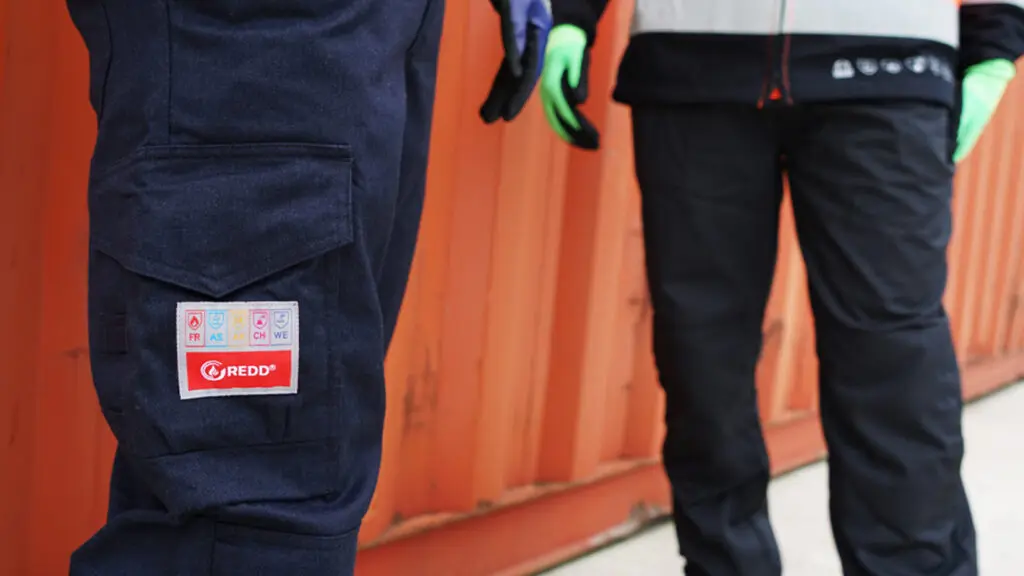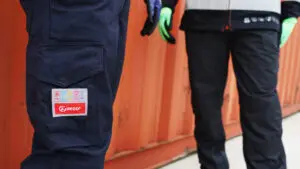Flame retardant (FR) clothing is a vital part of personal protective equipment (PPE) for many industries, aiming to minimise burn injuries. FR clothing can be inherently flame resistant, i.e., the material itself is designed to resist ignition and self-extinguish; or treated to be flame retardant, i.e., a chemical coating is applied to the clothing to resist ignition and self-extinguish.
Keep reading to learn more about how FR workwear works, FR standards, and the importance of base layers.
Flame Retardant Workwear: How Does it Work?
When exposed to a flame, most non-FR clothing will ignite and continue to burn, often melting onto the wearer’s body. This causes serious, sometimes life-threatening, injuries to the individual. Flame retardant workwear is vital in industries where exposure to fire is a risk, as it is specifically designed to resist ignition, meaning it’s less likely to catch fire when exposed to a flame. This works by inhibiting the conduction of electricity and heat through the fabric.
If the FR fabric does ignite, it will not continue to burn once the combustion source is removed due to its self-extinguishing properties. This gives staff the time to focus on extinguishing the combustion source, or to move away from the danger zone while staying protected.
The ignition resist and self-extinguishing attributes work together to protect the wearer in the event of a flash fire, electric arc, or other unexpected thermal risk. FR clothing greatly increases the chance of escape and can be the difference between severe injury and leaving unharmed.

Inherent Flame Resistance
Alternatively, a flame resistant garment may have been treated with a chemical that provides this resistance. Otherwise known as flame-retardant treated (FRT), this works through a chemical reaction, triggered by the heat of a flame. Although this provides a degree of protection when the product has been initially manufactured, this application is vulnerable to damage over time which can compromise the resistance of the garment. The user will be unable to determine whether protection has been compromised without putting the product through destructive tests.
Typical use of clothing, such as washing with detergent, can weaken or even eliminate the FR effectiveness when a product has only been treated with chemicals. Inherent flame resistance does not have this vulnerabililty. This benefit , alongside others such as Thermal Protective Performance, means inherent flame resistance is often the best choice in high risk environments.
Look for flame retardant workwear made with the below materials:
-
- Nomex
-
- Kevlar
-
- Modacrylic
-
- Aramids
These materials are made up of heat-resistant fibres, and are not chemically treated, meaning the FR qualities will not diminish over time. Alternatively, non-FR fabrics such as cotton can be chemically treated to boost their existing protective and heat resistant qualities. Chemical solutions such as Proban and Pyrovatex can be used to treat cotton fibres to make the fabric resistant to melting when exposed to heat. These chemicals are not inherent to the fabric; therefore, the FR qualities will fade over time through use and washing.
Flame Retardant Workwear: Arc Rating
Flame retardant workwear is not the same as arc flash clothing. Arc-rated (AR) workwear will have an arc-flash rating based on thorough testing and should be used in working environments with electrical safety hazards.
An arc flash is an electrical explosion, sometimes referred to as an ‘electrical arc’ or ‘flashover’. Temperatures can reach over 19000°C in an arc flash explosion, making it vital for those working in environments where arc flash incidents are a risk to have the correct PPE.
Arc flash clothing aims to reduce second-degree burns caused by an incident, with key features including:
-
- High performing inherently flame-retardant fabric, 250gsm
-
- Anti-static
-
- Long sleeved with ribbed cuffs
-
- FR heat reflective tape
-
- Fully certified to all arc flash safety standards
Arc flash clothing is effective against flame and arcs, whereas flame retardant clothing may be resistant to flame but not an arc flash. Arc resistant clothing insulates FR clothing from arc flashes.
ELIM and ATPV ratings are used to determine the safety performance of arc clothing. ATPV (Arc Thermal Performance Value) is based on burns that result in a 50% likelihood of second degree burns under fabric. If the wearer has less than 50% second degree burns, they are far more likely to survive the incident. ELIM (Energy Limit Value) is the point at which the clothing will give a 0% probability of the individual receiving a second-degree burn. This test (Open Arc Test) factors in incident energy levels to calculate the likelihood of injury.
You will find a number alongside both ATPV and ELIM codes showing their rating, which can be used to determine whether the clothing will be suitable to protect employees in their working environment. This will depend on risk assessments carried out internally by the organisation.
Flame Retardant Workwear Safety Standards
Official safety standards regulate protective clothing, including FR and flame resistance. The applicable standards are:
-
- ISO 11612:2008 Protective clothing to protect against heat and flame. Includes garments made from flexible materials where the user may be exposed to radiant or convective heat or molten metal splashes (e.g., during welding).
-
- EN ISO 14116:2008 Protective clothing to protect against heat and flame – limited flame spread. Includes protection for users during occasional and brief contact with small sources of ignition/flames.
-
- EN 11611:2008 Protective clothing for use in welding and allied processes. Includes protection from flame (short term contact), radiant heat from the arc, and electrical shock from conductors up to 100v (voltage).
-
- EN 1149-5:2008 Protective clothing – electrostatic properties. Includes material and design specifications for electrostatic dissipative clothing, used within a total earthed system to protect against incendiary discharges.
-
- IEC 61482 Protective clothing against thermal hazards of electric arc. Includes material and garment requirements for protective clothing against thermal hazards of an electrical arc (for electrical workers).
Why are base layers important?
FR base layers are the final line of defence against serious injuries. They offer additional protection against flame or arc flash hazards. Though the outer garments would normally be sufficient protection against a thermal event, occasionally the flame could burn through the outer layer, and affect the layers underneath. This is why it is vital that no synthetic materials are worn underneath the outer FR layer as it will ignite and continue to burn and melt onto the wearer’s skin. Polyester, nylon, and acetate should never be worn as a base layer.
An FR base layer is required whenever an individual is wearing their regular flame-retardant workwear (such as a coverall). Base layers can also provide additional warmth, comfort, and moisture wicking. Base layers may also be required to achieve ATPV ratings.
It is the employer’s responsibility to ensure that their employees are equipped with the right PPE to protect them in the workplace. This includes providing flame retardant and arc flash rated workwear where needed, and guidance on how to ensure their PPE is being worn effectively (i.e., with base layers).
For more information on FR Safety Standards, visit the International Organization for Standardisation website.
STAY INFORMED
Get in touch with our team to learn more about flame retardant workwear options.
Keep yourself informed and compliant through PWS’ Knowledge Hub. Through this regularly updated resource, we aim to keep you updated with legislation, H&S information and white papers like this one.
